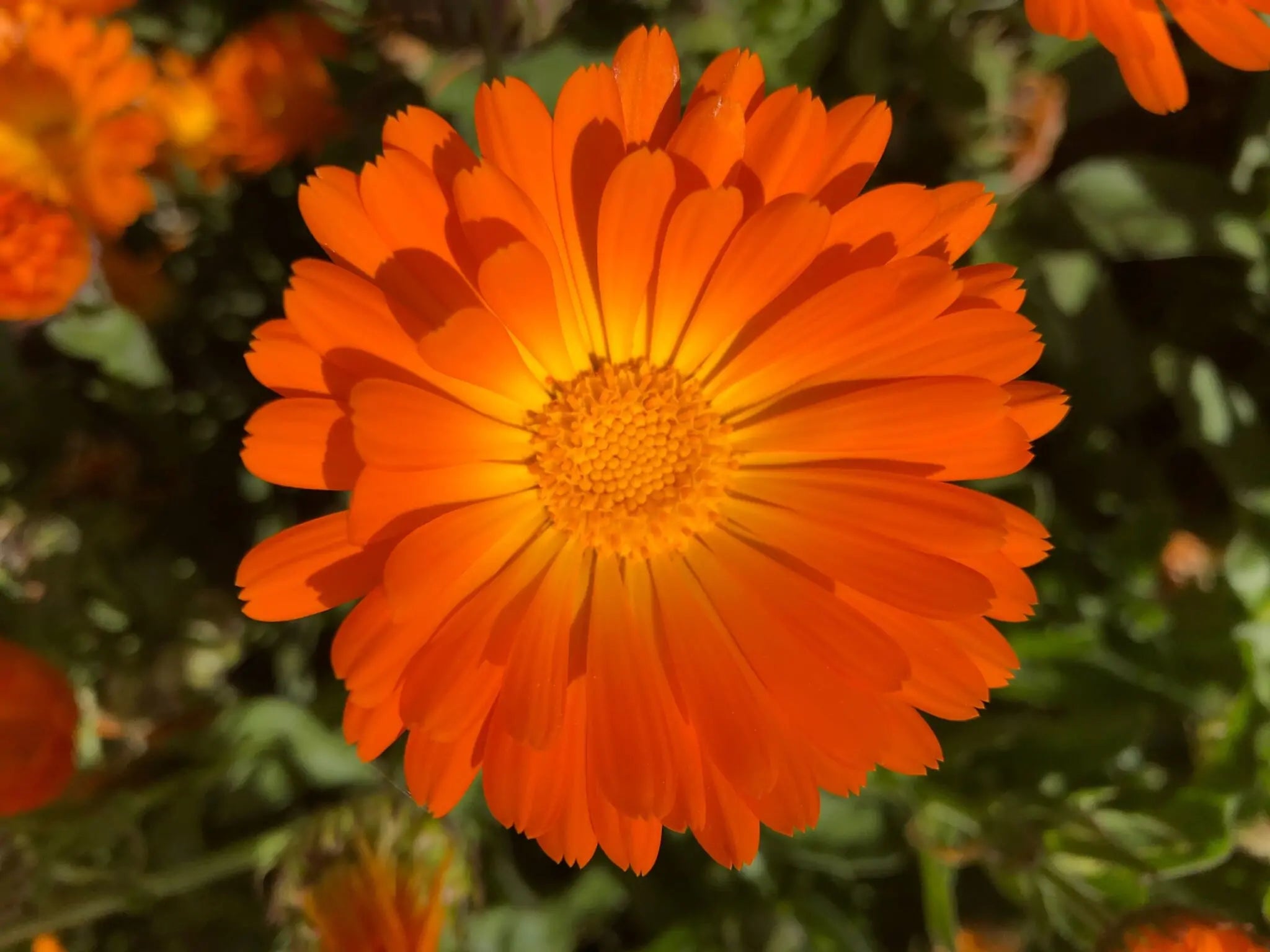Calendula has long been known for its diverse gardening, culinary, and medical benefits. A plant that can do it all, the brightly colored calendula flower petals make them an eye-catching addition to a garden and their healing properties make them a go-to in the first-aid cabinet.
WHAT IS CALENDULA?



Calendula officinalis for long—also known as the “Pot Marigold”— is a plant within the family Asteraceae. It is native to the Mediterranean region of Europe, although it can now be found around the world. Calendula plants stand out with bright petals, usually yellow or orange, growing 1-2 feet tall. Its narrow petals are described as a sunray shape. In addition to being a culinary tool, Calendula is best known for its medicinal uses.
The flower is widely used as a medicinal plant whose antibacterial, antifungal, and anti-inflammatory properties make it a strong ingredient for healing. In addition to using whole petals, Calendula flowers can be ground into powder or made into oils, creams, and ointments. The FDA has approved calendula for use as a spice and as an ingredient in cosmetics, soaps and shampoos, body creams, and wound treatment, both internally and topically.

5 HEALTH BENEFITS OF CALENDULA
Calendula really is a Jill of all trades. With the capacity to address a host of health issues, this plant has the potential to make its way around your entire home: from the garden, to the kitchen, to the medicine cabinet.
1. Heals Wounds
Calendula is primarily known as a healing plant because of its soothing abilities. Although a gentle herb, the healing effects derived from Calendula petals are very powerful, making it a must-have in the medicine cabinet. It is beneficial for any wound healing you may need including insect bites, bruises, blisters, cuts, and cold sores. Topical application of Calendula is used to keep wounds clean and help new tissue to grow. It is often used to help poorly healing wounds, those that are exhibiting signs of tenderness, redness, or inflammation, to correct course.
The healing herb is also effective in treating minor burns, including sunburn. It assists in sun protection and may consequently be included in sunscreen formulas for preventative care. Calendula cream, ointment, or healing balm may be applied to wounds to reduce swelling and their antimicrobial components, specifically their antifungal agents, can prevent secondary infection, leading to a quicker healing process.
2. Assists with Digestive and Immune System
Just like topical Calendula can remedy external wounds and burns, it also soothes internal wounds and burns like ulcers, heartburn or irritable bowel syndrome. It has a protective effect for the stomach that improves digestion by repairing the gut wall while relieving discomfort in the meantime.
The vulnerary capacity of Calendula can be called on to kick the leftover infection caused by a passing flu or cold. Calendula has been shown to strengthen the immune system’s ability to fight off infection. This is likely due to the fact that Calendula is antimicrobial, which means it slows or kills infection to prevent it from spreading. Its antibacterial properties give it the power to fight that lingering cough or congestion you can’t seem to get rid of.
Some research has established a link between gut health and mental health, including the experience of depression. With Calendula’s ability to repair and improve gut function, this connection would compound the impact of Calendula to positively affect brain activity as well.

3. Hydrates and Nourishes Dry Skin
Calendula has can be used to relieve many types of skin conditions that may cause dry, itchy, or irritated areas. It soothes skin experiences symptoms of eczema, dermatitis, and dandruff. By promoting the production of collagen, an essential protein for glowing skin, Calendula aids in sustaining soothed, hydrated skin. Although strong in effect, the gentleness of the herb often makes Calendula a skin care benefit that can be enjoyed even by many of those with skin sensitivities.
And who has more sensitive or delicate skin than babies? Parents tend to be careful when applying products to their babies’ rashes or irritations. But, Calendula is so safe and effective, it appears in many products for kids. As a natural remedy option, it is often preferred for prevention and treatment of rashes and irritations that babies experience like diaper rash and cradle cap.
4. Slows Development of Wrinkles
Calendula has also been found to assist in slowing the development of wrinkles. The antioxidants and anti-inflammatory compounds in Calendula have been found to significantly protect against oxidative stress in human skin cells. Oxidative stress is an imbalance of damaging atoms and antioxidants. Oxidative stress plays a large role in the aging process as well as the development of several illnesses. Calendula allows it to keep skin hydrated and healthy making it a great component for daily lotions or lip balm.
5. Reducing Scarring
One of the prominent Calendula benefits is its ability to reduce scarring when used to treat wounds. The Calendula properties that benefit wound healing apply to the scarring process as well. Calendula increases blood flow to the injury, promotes a speedy and healthy healing process, free of infection, and encourages growth of healthy new tissue. In the cases of skin ulcers like chicken pox and acne, the herb softens and soothes the skin, preventing inflammation, boosting the immune response, which allows wounds to heal quickly and cleanly.

HOW TO GROW CALENDULA

If you are interested in bringing Calendula into your life, you can always buy dried flowers and receive all the benefits the plant has to offer minus the lively colors of live flowers. But, if you are interested in gardening, Calendula is a great addition for even the most novice gardener.
Calendula is an easy-care, low maintenance plant. It isn’t picky about its soil type and requires limited watering with, of course, consideration of the season. It is drought resistant and frost tolerant. Calendula plants do not require any special care. It can grow in the sun or in the shade, in an outside planter, or in a pot indoors. So many options!
Once Calendula begins to bloom, harvest the flowers every 2-4 days to keep the flowers full and abundant. As you pick the flowers, more will blossom. In mild climates, Calendula may be a perennial (a plant that lives more than two years). Although Calendulas can weather light frost, where there are more severe winters, Calendula is typically considered an annual (a plant that has a one-year life span). Where it is an annual, however, it is capable of self-seeding for the following year.
WAYS TO USE CALENDULA
1. Tea
One prevalent way of getting many of the benefits Calendula has to offer to prepare it as a tea. This requires powdered or dried Calendula that is then steeped in boiling water for 10-20 minutes. This tea can be used to drink or as a mouth rinse to treat a sore throat or wounds within the mouth. If steeped to be especially strong, Calendula tea can also be used as a healing warm compress for eye infections.
2. Calendula Oil
Calendula oil is a common method of topical medicinal use. It is made by infusing Calendula flowers in a warmed oil for several weeks, stirring it daily. Some oils to consider are carrier oil, olive oil, or jojoba oil The anti-inflammatory and antiseptic compounds in the oil are fantastic for wound healing and the various skin conditions already mentioned. In addition, the resulting oil can be used in formulas for smooth application of products like sunscreens to get the natural protective and remedy benefits of the plant.
3. Cream/Ointment
Once you have an infused oil, you may be interested in cooking up a cream or Calendula ointment for easy topical application. This can be created by combining the oil with additional ingredients like beeswax, additional essential oils.
4. Calendula extract
Extract from the Calendula flower can also be used as a soothing ingredient within formulas for many products used habitually like deodorant and body lotion. These products help bring the healing properties of Calendula into your daily regimen.

RISKS OR POTENTIAL SIDE EFFECTS OF CALENDULA
Some people with sensitivities or allergies to pollen, like ragweed or marigolds, experience allergic reactions to calendula as a side effect of their underlying allergy. That is something to look out for before you start exploring the exceptional benefits Calendula has to offer!







